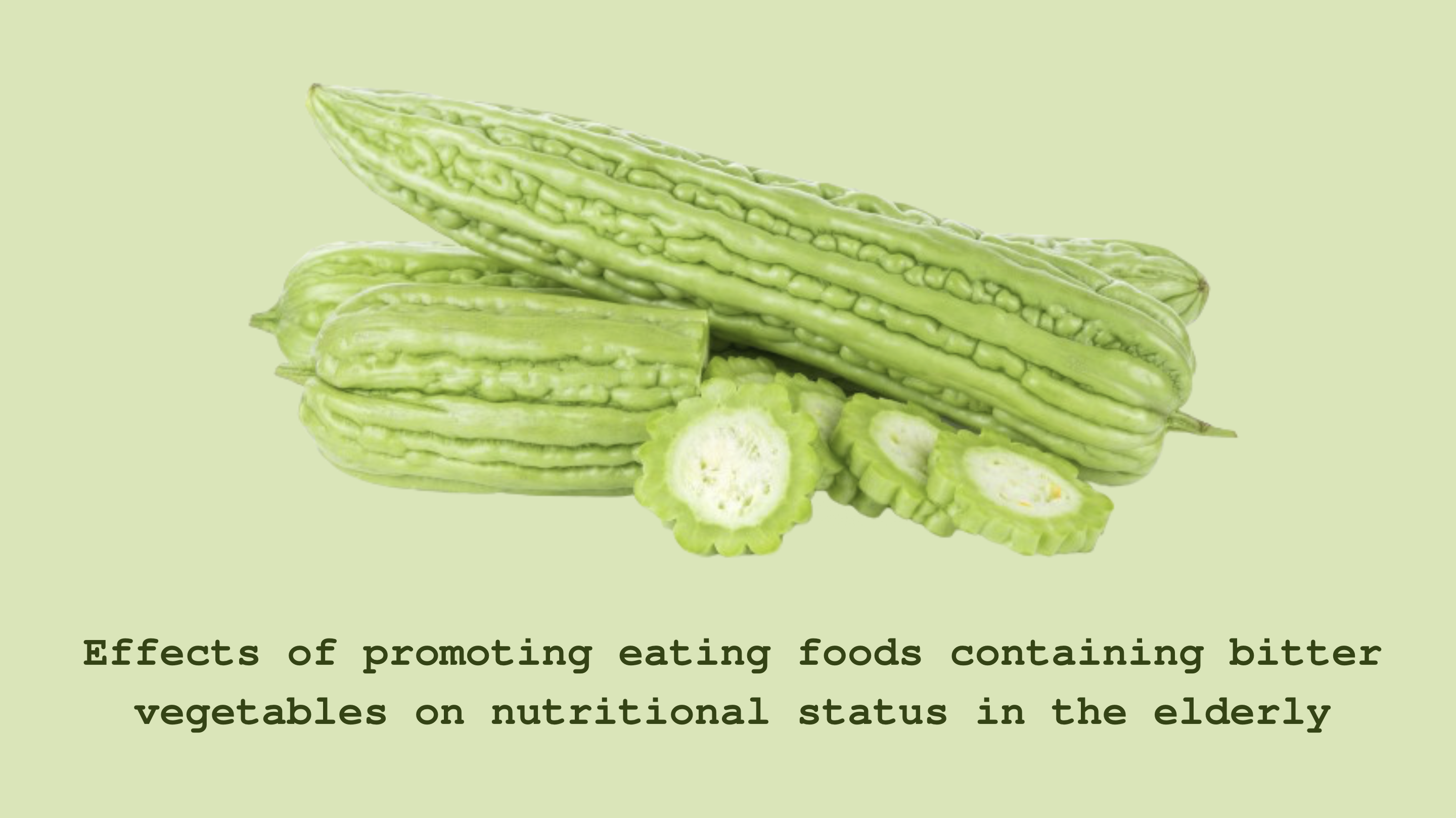Effects of promoting eating foods containing bitter vegetables on nutritional status in the elderly
Main Article Content
Abstract
Background: Non-communicable diseases pose a considerable risk for the elderly population. This study aimed to investigate the impact of incorporating bitter vegetables into the diets of elderly individuals on their nutritional status. The study involved regular consumption of northern foods, such as Malidmai (Peka), salae, neem (neem), bitter gourd, and cassia, at least once a day for three months.
Materials and methods: A randomized clinical trial recruited eighty individuals aged 60 years and above. One group was allowed to eat ad libitum, while the other group followed a recommended menu that emphasized bitter flavors. The study assessed dietary intake, body composition, and blood biochemical parameters.
Results: The findings revealed a significant reduction in energy, saturated fat, and cholesterol intake, with the bitter group experiencing a statistically significant decrease in sugar consumption. The bitter group also demonstrated a considerable reduction in anthropometric and metabolic parameters when compared to the control group and baseline measures. These results indicate the potential benefits of bitter substances in managing or preventing obesity and type 2 diabetes in the elderly.
Conclusion: Encouraging the elderly to consume at least one bitter meal per day for 12 weeks resulted in a reduction in weight gain, adipose tissue, sugar levels, and LDL-C. The study highlights the importance of incorporating bitter vegetables into the diets of elderly individuals for better nutritional status and health outcomes.
Article Details

This work is licensed under a Creative Commons Attribution-NonCommercial-NoDerivatives 4.0 International License.
Personal views expressed by the contributors in their articles are not necessarily those of the Journal of Associated Medical Sciences, Faculty of Associated Medical Sciences, Chiang Mai University.
References
Pramote Prasartkul, Jongjit Rittirong, Sutthida Chuanwan, Napaphat Satchanawakul, Suporn Jaratsit, Kanchana Thianlai (2022). Situation of the Thai Older Persons 2021. Institute for Population and Social Research, Mahidol University; Nakhon Pathom. ISBN: 978-616- 443-686-2.
Shilpa Amarya, Kalyani Singh and Manisha Sabharwal. Aging Process and Physiological Changes. Reviewed: March 6th, 2018 Published: July 4th, 2018 doi: 10.5772/intechopen.76249
Pugnaloni S, Alia S, Mancini M, Santoro V, Di Paolo A, Rabini RA, Fiorini R, Sabbatinelli J, Fabri M, Mazzanti L, Vignini A. A Study on the Relationship between Type 2 Diabetes and Taste Function in Patients with Good Glycemic Control. Nutrients. 2020; 12(4): 1112. doi: 10.3390/nu12041112.
Sergi G., Bano G., Pizzato S., Veronese N., Manzato E. Taste loss in the elderly: Possible implications for dietary habits. Crit Rev Food Sc Nutr. 2017; 57(17): 3684-9, doi: 10.1080/10408398.2016.1160208.
Avau B, Bauters D, Steensels S, Vancleef L, Laermans J, Lesuisse J, Buyse J, Lijnen HR, Tack J, Depoortere I. The Gustatory Signaling Pathway and Bitter Taste Receptors Affect the Development of Obesity and Adipocyte Metabolism in Mice. PLoS One. 2015; 10(12): e0145538. doi: 10.1371/journal.pone.0145538.
Chen MC, Wu SV, Reeve JR Jr, Rozengurt E. Bitter stimuli induce Ca2+ signaling and CCK release in enteroendocrine STC-1 cells: role of L-type voltage-sensitive Ca2+ channels. Am J Physiol Cell Physiol. 2006; 291(4): C726-39. doi: 10.1152/ajpcell.00003.2006.
Kim KS, Egan JM, Jang HJ. Denatonium induces secretion of glucagon-like peptide-1 through activation of bitter taste receptor pathways. Diabetologia. 2014; 57(10): 2117-25. doi: 10.1007/s00125-014-3326-5.
Marathe CS, Rayner CK, Jones KL, Horowitz M. Relationships between gastric emptying, postprandial glycemia, and incretin hormones. Diabetes Care. 2013; 36(5): 1396-405. doi: 10.2337/dc12-1609.
Steinert RE, Feinle-Bisset C, Asarian L, Horowitz M, Beglinger C, Geary N. Ghrelin, CCK, GLP-1, and PYY(3- 36): Secretory Controls and Physiological Roles in Eating and Glycemia in Health, Obesity, and After RYGB. Physiol Rev. 2017; 97(1): 411-63. doi: 10.1152/physrev.00031.2014.
Murphy KG, Bloom SR. Gut hormones and the regulation of energy homeostasis. Nature. 2006; 444(7121): 854-9. doi: 10.1038/nature05484.
Pan WH, Yeh WT. How to define obesity? Evidencebased multiple action points for public awareness, screening, and treatment: an extension of AsianPacific recommendations. Asia Pac J Clin Nutr. 2008; (3): 370-4.
Kıskaç M, Soysal P, Smith L, Capar E, Zorlu M. What is the Optimal Body Mass Index Range for Older Adults? Ann Geriatr Med Res. 2022; 26(1): 49-57. doi: 10.4235/agmr.22.0012.
Bae YJ, Shin SJ, Kang HT. Body mass index at baseline directly predicts new-onset diabetes and to a lesser extent incident cardio-cerebrovascular events, but has a J-shaped relationship to all-cause mortality. BMC Endocr Disord. 2022; 22(1): 123. doi: 10.1186/s12902-022-01041-3.
Bai K, Chen X, Song R, Shi W, Shi S. Association of body mass index and waist circumference with type 2 diabetes mellitus in older adults: a cross-sectional study. BMC Geriatr. 2022; 22(1): 489. doi: 10.1186/s12877-022-03145-w.
Dietary reference intake for Thais 2020. The Committee on Allowances, Recommended Daily Dietary Nutrition Division, Department of Health, Ministry of Public Health. A.V. Progressive LTD., Bangkok. 2020. (in Thai).
Carson JAS, Lichtenstein AH, Anderson CAM, Appel LJ, Kris-Etherton PM, Meyer KA, Petersen K, Polonsky T, Van Horn L; American Heart Association Nutrition Committee of the Council on Lifestyle and Cardiometabolic Health; Council on Arteriosclerosis, Thrombosis and Vascular Biology; Council on Cardiovascular and Stroke Nursing; Council on Clinical Cardiology; Council on Peripheral Vascular Disease; and Stroke Council. Dietary Cholesterol and Cardiovascular Risk: A Science Advisory From the American Heart Association. Circulation. 2020; 141(3): e39-e53. doi: 10.1161/CIR.0000000000000743.
Witek K, Wydra K, Filip M. A High-Sugar Diet Consumption, Metabolism and Health Impacts with a Focus on the Development of Substance Use Disorder: A Narrative Review. Nutrients. 2022; 14(14): 2940. doi: 10.3390/nu14142940.
Rezaie P, Bitarafan V, Horowitz M, Feinle-Bisset C. Effects of Bitter Substances on GI Function, Energy Intake and Glycaemia-Do Preclinical Findings Translate to Outcomes in Humans? Nutrients. 2021; 13(4): 1317. doi: 10.3390/nu13041317.
van Gemert WA, Peeters PH, May AM, Doornbos AJH, Elias SG, van der Palen J, Veldhuis W, Stapper M, Schuit JA, Monninkhof EM. Effect of diet with or without exercise on abdominal fat in postmenopausal women - a randomised trial. BMC Public Health. 2019; 19(1): 174. doi: 10.1186/s12889-019-6510-1.


